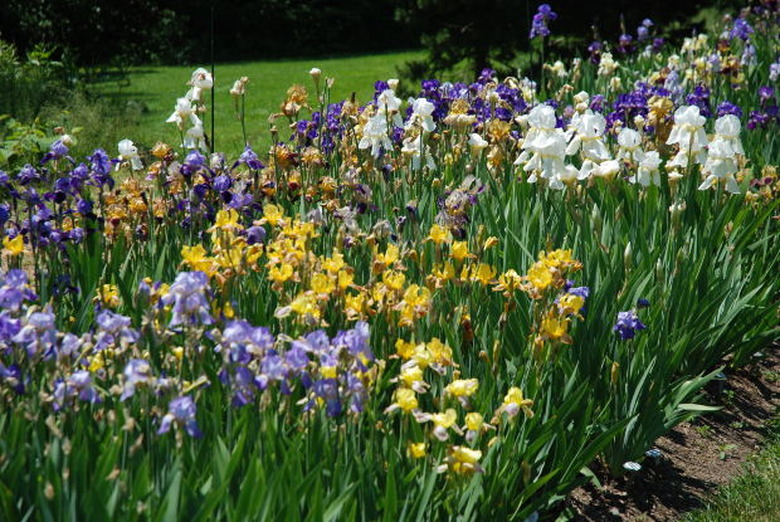How To Transplant Iris Bulbs
Transplanting iris bulbs not only increases the size of your iris bed, it revitalizes old iris plants as well. After several years of growing in the same location, rhizomes multiply and roots begin to crowd, reducing bloom size and producing pale blooms. Bigger, brighter blooms will reward an afternoon's work of digging and transplanting the bulbs the following year.
Step 1
Prepare a new location for iris in a sunny location. Till the soil to a depth of 6-8 inches. Remove rocks or roots and amend the soil with compost or well-rotted manure. Work amendments into the existing soil.
- Transplanting iris bulbs not only increases the size of your iris bed, it revitalizes old iris plants as well.
Step 2
Dig iris bulbs once the foliage begin to die back in late summer. Although gardeners commonly refer to these as bulbs, many common irises actually produce rhizomes, a thickened root with roots along the bottom and sides of the tuber. Rhizomes grow near the surface of the soil and produce new rhizomes each year. Lift the bulbs free of soil with a garden fork or spade.
Step 3
Trim foliage to a height of 4–6 inches for easy handling. Gently tug the rhizomes to pull them apart. Cut individual rhizomes away from the main bulb with a sharp knife if necessary. Each section must have several white roots.
- Dig iris bulbs once the foliage begin to die back in late summer.
- Cut individual rhizomes away from the main bulb with a sharp knife if necessary.
Step 4
Inspect rhizomes for any signs of disease or insect damage. Healthy rhizomes are firm and plump. Discard any mushy or discolored bulbs.
Step 5
Plant rhizomes so that the top one-third of the bulb is above the surface of the soil. Firm soil down around the rhizome and water thoroughly. Keep soil moist throughout the fall to help your iris develop strong root systems. Growth resumes in spring, rewarding you with robust growth and large, showy blooms.
- Inspect rhizomes for any signs of disease or insect damage.
- Keep soil moist throughout the fall to help your iris develop strong root systems.
Plant Iris Bulbs
Irises (Iridaceae), growing in shades of purple, pink, blue, yellow and many colors in between, are six-petaled flowers. They may be bearded — with three upright petals and three hanging ones — or beardless, with smooth, symmetrical falls. However, with the exception of Pacific Coast Native irises (PNC), which bloom first, beardless varieties produce flowers after the bearded flowers fade. Beardless irises also have fibrous-rooted rhizomes; their tops must be planted slightly beneath the soil. Some beardless irises may be planted in early spring. In zones 9 and 10, irises and other flowering bulbs growing in Mediterranean climates but hardy to cooler regions may be planted from mid-August into December or mid-October through late January, notes the website ColorBlends. Irises need direct sunlight and room to spread. Apply organic mulch after fall plantings to protect tender root systems. After blooms die, cut iris stalks back to an inch or two above the ground to prevent seeds from forming. Fertilize irises with a 5-10-10 solution but do not let rhizomes come in direct contact with the chemicals.
- Irises (Iridaceae), growing in shades of purple, pink, blue, yellow and many colors in between, are six-petaled flowers.
- Beardless irises also have fibrous-rooted rhizomes; their tops must be planted slightly beneath the soil.
Things Needed
- Garden fork/spade
- Compost
- Well-rotted manure
- Sharp knife
- Clippers (optional)
References
- North Dakota State University Extension
- North Carolina State University
- The New Sunset Western Garden Book; Kathleen Norris Brenzel, ed.
- Colorblends: USDA Zones and Fall Bulb Planting
- North Carolina State University Cooperative Extension: Bearded Iris for the Home Landscape
- American Meadows: All Kinds of Irises
- Colorado State University Extension: Irises
- Rainbow Iris Farm: Growing Bearded Iris
